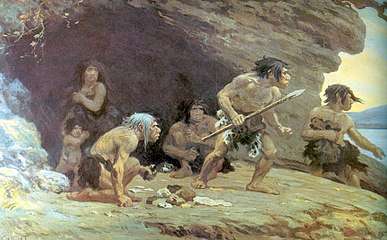Caveman
A caveman is a stock character representative of primitive man in the Paleolithic. The popularization of the type dates to the early 20th century, when Neanderthal Man was influentially described as "simian" or ape-like by Marcellin Boule[1] and Arthur Keith.[2]

While knowledge of human evolution in the Pleistocene has become much more detailed, the stock character has not disappeared, even though it anachronistically conflates characteristics of archaic humans and early modern humans.
The term "caveman" has its taxonomic equivalent in the now-obsolete Homo troglodytes, (Linnaeus, 1758).[3]
Characteristics

Cavemen are typically portrayed as wearing shaggy animal hides, and capable of cave painting like behaviorally modern humans of the last glacial period. Anachronistically, they are simultaneously shown armed with rocks or cattle bone clubs that are also adorned with rocks, unintelligent, and aggressive. Popular culture also frequently represents cavemen as living with or alongside dinosaurs, even though non-avian dinosaurs became extinct at the end of the Cretaceous period, 66 million years before the emergence of the Homo sapiens species.
The image of them living in caves arises from the fact that caves are where the preponderance of artifacts have been found from European Stone Age cultures, although this most likely reflects the degree of preservation that caves provide over the millennia rather than an indication of their typical form of shelter. Until the last glacial period, the great majority of hominins did not live in caves, being nomadic hunter-gatherer tribes living in a variety of temporary structures, such as tents[4] and wooden huts (e.g. at Ohalo). Their societies were similar to those of many modern day indigenous peoples. A few genuine cave dwellings did exist, however, such as at Mount Carmel in Israel.[5]
Stereotypical cavemen have traditionally been depicted wearing smock-like garments made of animal skin and held up by a shoulder strap on one side, and carrying large clubs approximately conical in shape. They often have grunt-like names, such as Ugg and Zog.[6]
History

Caveman-like heraldic "wild men" were found in European and African iconography for hundreds of years. During the Middle Ages, these creatures were generally depicted in art and literature as bearded and covered in hair, and often wielding clubs and dwelling in caves. While wild men were always depicted as living outside of civilization, there was an ongoing debate as to whether they were human or animal.
In Sir Arthur Conan Doyle's The Lost World (1912), ape-men are depicted in a fight with modern humans. Edgar Rice Burroughs adapted this idea for The Land That Time Forgot (1918). A genre of caveman movies emerged, typified by D. W. Griffith's Man's Genesis (1912); they inspired Charles Chaplin's satiric take,[7] in His Prehistoric Past (1914) as well as Brute Force (1914), The Cave Man (1912), and later Cave Man (1934). From the descriptions, Griffith's characters cannot talk, and use sticks and stones for weapons, while the hero of Cave Man is a Tarzanesque figure who fights dinosaurs.
D. W. Griffith's Brute Force, a silent film released in 1914, represents one of the earliest portrayals of cavemen and dinosaurs together, with its depiction of a Ceratosaurus.[8][9] The film reinforced the incorrect notion that non-avian dinosaurs co-existed with prehistoric man.[9]
The anachronistic combination of cavemen with dinosaurs eventually became a cliché, and has often been intentionally invoked for comedic effect. The comic strips B.C., Alley Oop, the Spanish comic franchise Mortadelo y Filemón, and occasionally The Far Side and Gogs portray "cavemen" with dinosaurs. Gary Larson, in his The Prehistory of the Far Side, stated he once felt that he needed to confess his cartooning sins in this regard: "O Father, I Have Portrayed Primitive Man and Dinosaurs In The Same Cartoon".[10] The animated series The Flintstones, a spoof on family sitcoms, portrays the Flintstones even using dinosaurs, pterosaurs and prehistoric mammals as tools, household appliances, vehicles, and construction machines.[11]
Stereotypical cavemen are also often featured in advertising, including advertisements for Minute Maid. In early 2004, GEICO launched a series of television commercials and attempts at viral marketing, collectively known as the GEICO Cavemen advertising campaign, where GEICO announcers are repeatedly denounced by modern cavemen for perpetuating a stereotype of unintelligent, backward cavemen. The GEICO advertisements spawned a short-lived TV series called Cavemen.
References
- "Ape-like or human? Disagreement erupts over Neanderthal posture". Cosmos. Retrieved 2020-04-13.
- "Early Man in Palestine". Nature. 129 (3268): 898–898. 1932-06-01. doi:10.1038/129898b0. ISSN 1476-4687.
- Isabella, Jude (2013-12-05). "The Caveman's Home Was Not a Cave". Nautilus. Retrieved 2020-04-13.
- Jerry D. Moore, "The Prehistory of Home", University of California Press, 2012
- "Carmel Caves - How to meet a caveman - Israel Guide - Jerusalem Post". www.jpost.com. Retrieved 2019-10-18.
- "Contents Page: 82". www.depauw.edu. Retrieved 2019-05-08.
- Stills from Man's Genesis Archived 2008-07-20 at the Wayback Machine and His Prehistoric Past show that Chaplin still has his bowler hat.
- Rebecca Hawkes (24 November 2015). "Costumed pigs, iguanas and Raquel Welch: the evolution of movie dinosaurs". The Telegraph. Retrieved 15 May 2020.
- Glut, Donald F.; Brett-Surman, Michael K. (1997). "Dinosaurs and the media". The Complete Dinosaur. Bloomington and Indianapolis: Indiana University Press. pp. 675–706. ISBN 978-0-253-33349-0.
- Larson, Gary (1989). The Prehistory of The Far Side. Andrews McMeel. ISBN 0-8362-1851-5.
- Blake, Heidi (30 September 2010). "The Flintstones' 50th anniversary: 10 wackiest Bedrock inventions". Daily Telegraph.
External links
- Origin of Man at The Encyclopedia of Science Fiction
- Apes a Man at The Encyclopedia of Science Fiction
- Cavemen at Comic Vine